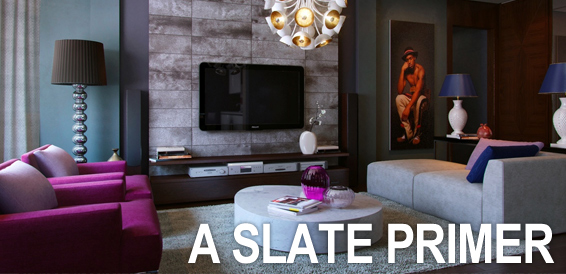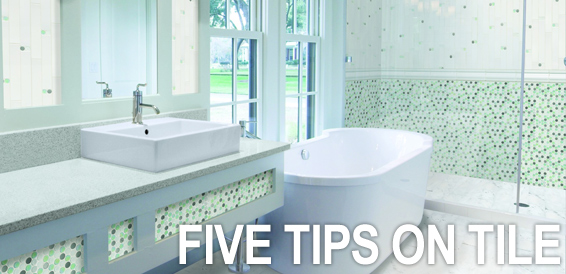The Skinny on Slate
What is slate?
Slate is a natural stone or rock. Rock is made up of minerals and other rocks that give it color. Natural slate usually refers to two different products; slate that originated as shale, and quartzite that originated as sandstone. Both products are metamorphic rocks, which means that over time, and under heat and pressure, they have changed in form from their original appearance and characteristics. Both slate and quartzite are quartz-based (siliceous) products. This means they share certain characteristics with granite (another siliceous stone), the most important being chemical and acid resistance.
How is slate produced?
When you look at the edge of a slate tile, you can see it’s comprised of multiple thin layers. These layers indicate how slate looks in its natural form. Slate is usually split from the quarry in layers. These layers form surface clefting, which is gives slate its pronounced surface texture. The slate is then cut into tiles or trim shapes, and it can be natural clefted, tumbled or honed.
What is honed slate?
The face of a slate tile is naturally clefted or uneven. However there are applications where a smooth face is desirable. Some slates and quartzites can have the face ground down to a smooth faced product. This process is known as honing. Many honed quartzites still have an appearance of depth and texture because of their mineral content.
What is gauged slate?
Grinding or machining one side gauges the slate. Gauging is done for two reasons: to create thickness within a defined range and to provide a flat back for ease of installation. Keep in mind that gauged slate will vary in thickness, but the range of thickness is less than a natural random thickness. Think of slate as a naturally rough stone. It’s cut into squares and gauged but not within the precise dimensional measurements of other stones like travertine or granite.
What colors does slate come in?
Slate factories may mix tiles from multiple quarries to develop extreme color ranges, and there are slates that are fairly consistent in color. You’ll find that most slates are within a color spectrum like golds and greens, browns and blacks, reds and rust or sandy beiges. Slate should be initially selected from an array of 6-9 samples tiles in order to see the anticipated color range. Final selection should be from as many pieces as you need to see to feel comfortable with the color range. This can be as few as 3-4 pieces, a picture of multiple pieces, or several actual pieces from each pallet that you’ll be receiving. See enough pieces in order to be assured that the slate you receive meets your expectations before your signed approval.
Can slate be installed outdoors?
Slate is a great choice for many outdoor installations. The natural textured (clefted) face of a slate tile provides excellent slip resistance. The multiple earthy colors of slate complement almost any style and color scheme. There are even a few slates that can withstand intense freeze-thaw cycles, but request written laboratory test results before installing slate in snowy conditions.
Can slate be installed in wet areas?
Because of its density and high chemical resistance, slate is ideal for use on patio and pool decks, as well as kitchen and baths. Slate isn’t usually recommended for areas with standing water such as inside pools, waterfalls or fountains. Natural stones should never be used in steam showers.
Should slate be sealed?
It’s not usually necessary to seal slate outdoors. However, as with any natural stone tile, slate installed indoors should be sealed with a high quality penetrating sealer. Sealer should be reapplied every 1-5 years depending on manufacturer’s recommendations and usage. Put a drop of water on the surface. If it beads up, your sealer is working. If it doesn’t, it’s time to reseal.
Insight
The objective is to understand the color, appearance and performance characteristics of the slate tile before it’s shipped so that the final installation would not only meet the buyers expectations, but will be more beautiful than they ever imagined.


